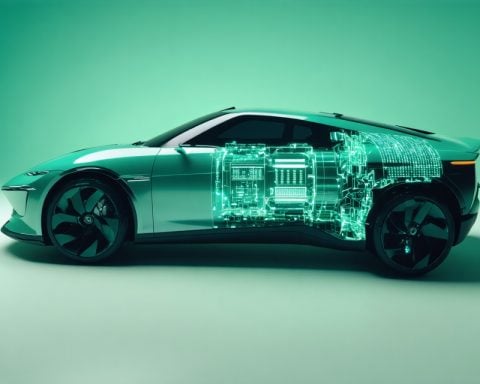- The latest advancement in solid-state battery technology could revolutionize electric vehicles with batteries that triple the charge capacity of current models.
- A collaborative breakthrough at the University of Western Ontario and the University of Maryland introduced a lithium-metal battery using a solid β-Li₃N electrolyte.
- The solid electrolyte significantly enhances energy density, reaching up to 500 Wh/kg, and facilitates faster charging times, potentially five times quicker than existing methods.
- Safety improves by eliminating flammable liquid electrolytes, with rigorous testing showing maintenance of over 92% capacity after 3,500 charging cycles.
- The new battery technology aims to address range anxiety and long charging durations, paving the way for a sustainable and efficient electric vehicle future.
- Challenges remain in scaling production and reducing costs, but successful implementation promises a pivotal shift in the automotive industry.
Imagine a future where electric vehicles glide effortlessly down bustling highways, powered by batteries that hold three times the charge of today’s models. This vision edges closer to reality thanks to a groundbreaking discovery in solid-state battery technology, promising to transform the electric vehicle landscape forever.
Researchers at the University of Western Ontario and the University of Maryland have unveiled a lithium-metal battery with a solid electrolyte—an innovative leap replacing the problematic liquid electrolytes of current lithium-ion batteries. This solid electrolyte, crafted from β-Li₃N (lithium nitride), enables lithium ions to dance freely, slashing resistance and turbocharging energy storage. The performance leap sends these batteries into uncharted territory, achieving energy densities of up to 500 Wh/kg, doubling their predecessors’ capabilities.
The transformation extends beyond energy storage, offering faster charging times, a critical hurdle for electric vehicle owners accustomed to lengthy waits. Imaging your electric car recharging five times faster, courtesy of this new technology—a boon for anyone planning a cross-country journey with minimal interruptions.
Additionally, safety concerns plagued by flammable liquid electrolytes are neatly sidestepped. The use of a solid electrolyte sidesteps this issue, delivering a battery that not only stores more energy but does so safely, all while preventing dendrite formation that often leads to battery failure. Tested rigorously, these cells proudly maintain over 92% capacity after 3,500 charging cycles, outliving present-day batteries by a significant margin.
As the promise of solid-state batteries looms, automakers face the demanding task of scaling production and slashing manufacturing costs. Yet, success could mean the heralding of a new epoch for electric vehicles, one where range anxiety and grueling charging sessions fade into obsolescence, setting the stage for a greener, more efficient future.
Revolutionizing Electric Vehicles: How Solid-State Battery Technology is Transforming the Industry
How-To Steps & Life Hacks
To fully understand and potentially utilize solid-state batteries in electric vehicles, it’s crucial to grasp both the concept and the practical steps involved in their integration:
1. Understand Solid-State Battery Components: Solid-state batteries replace the liquid electrolyte with a solid one, typically lithium metal, leading to denser energy storage and safety improvements. Familiarize yourself with terms like β-Li₃N (lithium nitride) to understand the materials involved.
2. Stay Updated with Developments: Follow updates from institutions such as the University of Western Ontario and the University of Maryland regarding advancements in battery technology.
3. Evaluate Current Vehicle Compatibility: For electric vehicle owners or potential buyers, verify if or when your model may support solid-state battery upgrades or consider future-proof models.
4. Research Installation Services: For those looking to upgrade, find qualified services equipped to handle solid-state battery installations, adhering to proper safety regulations.
Real-World Use Cases
1. Electric Vehicles: The most direct application is in EVs, where solid-state batteries can significantly extend range and reduce charging times, addressing two of the largest consumer hurdles.
2. Consumer Electronics: Smaller devices like smartphones and laptops can also benefit, experiencing longer battery life and faster charging, enhancing usability and convenience.
3. Grid Energy Storage: Solid-state technology can provide more efficient and safer energy storage solutions for renewable energy sources like solar and wind, becoming integral to grid infrastructure.
Market Forecasts & Industry Trends
A transition to solid-state batteries is anticipated to be a pivotal industry trend. According to a report by IDTechEx , the solid-state battery market is estimated to reach over $6 billion by 2030. Automotive giants like Toyota and BMW are heavily investing in solid-state research, predicting that these batteries will power their future electric models by mid-decade.
Reviews & Comparisons
Compared to conventional lithium-ion batteries, solid-state batteries promise enhanced performance:
– Energy Density: Solid-state batteries can reach up to 500 Wh/kg, doubling that of traditional lithium-ion batteries, offering greater vehicle range and application versatility.
– Safety: They dramatically reduce the risk of fire, a significant issue in lithium-ion technology, by eliminating flammable liquid electrolytes.
– Longevity: With such batteries maintaining 92% capacity over thousands of cycles, they assure a longer service life.
Controversies & Limitations
While solid-state battery technology shows immense promise, certain challenges remain:
– Manufacturing Costs: The production of solid-state batteries is expensive—approximately 2 to 3 times that of lithium-ion batteries, presenting initial cost barriers.
– Scalability Problems: Achieving mass production poses engineering and material challenges, which require significant R&D to overcome.
Security & Sustainability
Solid-state batteries provide enhanced security benefits by utilizing non-flammable materials, thus reducing the risk of fire and explosive failures prevalent in lithium-ion batteries.
In terms of sustainability:
– Longer Lifespan: They offer an extended lifespan, thus reducing waste and the need for frequent replacements.
– Recyclability: Continued development is needed to improve the recyclability of solid-state batteries fully, encouraging further investment in this area by manufacturers.
Pros & Cons Overview
Pros:
– Increased energy density
– Improved safety with non-flammable materials
– Longer lifespan and enhanced durability
– Faster charging capabilities
Cons:
– High production cost
– Production and scalability hurdles
Actionable Recommendations
– For Consumers: Keep an eye on automakers’ announcements regarding solid-state battery adoption.
– Invest in Future Technology: Consider investing in EVs from brands researching solid-state technology for potential early adopter advantages.
– Monitor Technological Updates: Use credible sources for updates on mass production breakthroughs or government incentives.
Stay informed on these advancements, as solid-state batteries are set to revolutionize the energy storage landscape.
For comprehensive insights into advancing technologies, visit Wired or Forbes.
















